



Books in the Field of Visual Thinking
Thinking Schools
David Hyerle and Larry Alper coeditors
Corwin Press, Second Edition, April 2014
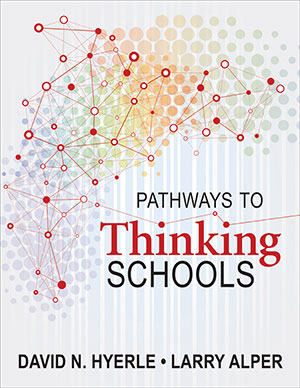 The title of this book represents a declaration of what many people inside
and outside of education from around the world now believe should be the central
focus of education. Presented within these chapters is documentation showing
how the explicit focus on thinking may become a foundation for every school,
from many different vantage points and from several different countries. In one
sense, our schools need to “recharter” their vision of schooling. We know that
our work as educators is no longer simply about delivering more content
knowledge, better technology or more complex testing regimens. We need to
explicitly develop our students? thinking abilities in order that they deepen content
knowledge, build concepts, and filter the abundance of information flowing
through virtual networks.
The title of this book represents a declaration of what many people inside
and outside of education from around the world now believe should be the central
focus of education. Presented within these chapters is documentation showing
how the explicit focus on thinking may become a foundation for every school,
from many different vantage points and from several different countries. In one
sense, our schools need to “recharter” their vision of schooling. We know that
our work as educators is no longer simply about delivering more content
knowledge, better technology or more complex testing regimens. We need to
explicitly develop our students? thinking abilities in order that they deepen content
knowledge, build concepts, and filter the abundance of information flowing
through virtual networks.
Student Successes With Thinking Maps®
David Hyerle and Larry Alper coeditors
Corwin Press, Second Edition, January 2011, Thousand Oaks, California
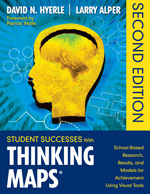 “The Thinking Maps® program takes full advantage of the natural proclivity of the brain to see and think visually. The authors describe Thinking Maps as a language of visual tools grounded in the thinking process, a most neurally apt description. This book provides an invaluable way to help our students truly understand and retain the concepts behind the facts, and to do this in an exciting and motivating way.”
“The Thinking Maps® program takes full advantage of the natural proclivity of the brain to see and think visually. The authors describe Thinking Maps as a language of visual tools grounded in the thinking process, a most neurally apt description. This book provides an invaluable way to help our students truly understand and retain the concepts behind the facts, and to do this in an exciting and motivating way.”
read more
Order the Book
Pat Wolfe, Author, Building the Reading Brain
In this ESaGS TV program video above, you will visit St MacNissi's Primary School in Glengormley, and hear from the principal, the Thinking Skills co-ordinator and the pupils as to how Thinking Maps are being used as one aspect of the school's focus on developing and directing pupil thinking.
For more on Student Successes With Thinking Maps go to the following links:
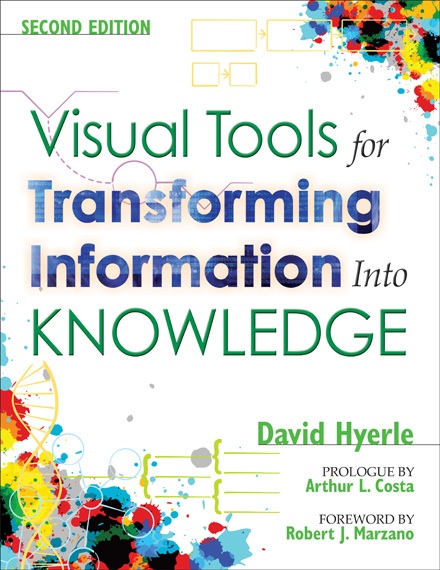 Visual Tools for Transforming Information Into Knowledge
Visual Tools for Transforming Information Into Knowledge
David Hyerle, Author
Arthur L. Costa, Prologue
Robert J. Marzano, Foreward
Corwin Press, 2009, Second Edition, 192 pages
This is the most comprehensive book on graphic organizers, Thinking Maps®, and graphic software programs. Find out why visual tools and mapping are the key tools for 21st century learning. Look at student and teacher work and review test results from around the country. In a rich and provocative writing style, David Hyerle, Ed.D. draws together examples from teachers, administrators, brain researchers, and parents to make a very exciting read.
Read excerpts from the following chapters and contents:
- Contents
- Chapter 1: The Mapping Metaphor
- Chapter 2: Facilitating the Networking Brain and the Patterning Mind
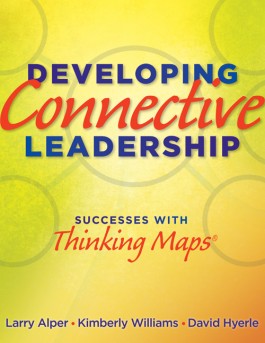 Developing Connective Leadership
Developing Connective Leadership
Successes With Thinking Maps®
Larry Alper, David Hyerle, Kimberly Williams, Authors
Solution Tree Press, 2012
"If our best thinking comes by making connections and building patterns, then what would these patterns look like, and what might they be based on?"—ask the authors. Most importantly, how could they be used?
Developing Connective Leadership shows you how Thinking Maps® are an efficient and eloquent language that can be used to explore and reveal ideas, thought processes, and intentions. By creating visual representations of thought, leaders create shared understandings and foster connections among staff.
Explore how schools have used the Thinking Maps® process to create strong collaborative bonds and facilitate shared leadership. As staff members collaborate to construct a shared frame of reference, they are empowered to execute and sustain the school's vision.
Benefits:
- Offers real-life experiences from school leaders using Thinking Maps® for professional development
- Identifies eight Thinking Maps® used to build connective leadership practices
- Suggests how Thinking Maps® can be used to reformulate and reconstruct negative or damaging frames of reference
- Discusses how Thinking Maps® can energize and inspire insight and solutions
A Field Guide to Using Visual Tools
David Hyerle, Author
Association for Supervision & Curriculum Development, 2000
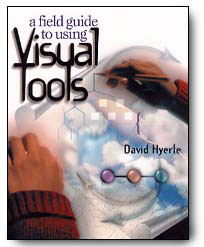 This is the most comprehensive book on graphic organizers, Thinking Maps®, and graphic software programs. Find out why visual tools and mapping are the key tools for 21st century learning. Look at student and teacher work and review test results from around the country. In a rich and provocative writing style, David Hyerle, Ed.D. draws together examples from teachers, administrators, brain researchers, and parents to make a very exciting read.
This is the most comprehensive book on graphic organizers, Thinking Maps®, and graphic software programs. Find out why visual tools and mapping are the key tools for 21st century learning. Look at student and teacher work and review test results from around the country. In a rich and provocative writing style, David Hyerle, Ed.D. draws together examples from teachers, administrators, brain researchers, and parents to make a very exciting read.
Reviews of A Field Guide to Using Visual Tools
Review of A Field Guide to Using Visual Tools by the National Writing Project
![]() Read the review online
Read the review online
![]() Download the Acrobat pdf file of the review
Download the Acrobat pdf file of the review
“A Field Guide to Using Visual Tools (Hyerle, 2000) is an excellent source of information regarding the many forms of graphics and their use in educational settings.”
Patricia Wolfe
Brain Matters — Translating Research into Classroom Practice, (ASCD 2001) p. 159
Review of A Field Guide to Using Visual Tools by American Association of School Administrators (AASA)
Reviewed by Paul A. Roberts - Principal, Glen Grove Elementary School, Glenview, Ill.
American Association of School Administrators, September 2001
“Thinking outside the box may or may not be the appropriate point of view as you experience A Field Guide to Using Visual Tools by David Hyerle. The "box" is a point of reference for graphic organizers and reflects a frame of reference that formally adds a new dimension to visual maps. This sequel to Visual Tools for Constructing Knowledge deals with the practical applications of thinking-process maps and gives real-life school examples.”
![]() Read the article online
Read the article online
![]() Download the Acrobat pdf file of the article
Download the Acrobat pdf file of the article
Visual Tools for Constructing Knowledge
David Hyerle, Author
Association for Supervision & Curriculum Development, 1996
Currently Out of Print
“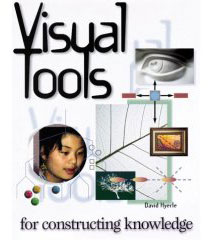 Deeply rooted in constructivist theory, this book draws on philosophical and psychological models of how the mind works, how human intellectual capacities emerge and grow over time, how humans derive meaning, and how knowledge is structured. The intent is to provide educators with insights into how interventions can be arranged and conditions organized so as to educe, enhance, and refine those human intellectual resources.” From the Prologue by Arthur L. Costa. Download and read the complete Prologue (Acrobat PDF file).
Deeply rooted in constructivist theory, this book draws on philosophical and psychological models of how the mind works, how human intellectual capacities emerge and grow over time, how humans derive meaning, and how knowledge is structured. The intent is to provide educators with insights into how interventions can be arranged and conditions organized so as to educe, enhance, and refine those human intellectual resources.” From the Prologue by Arthur L. Costa. Download and read the complete Prologue (Acrobat PDF file).
Read the complete first edition (1996) — Download Visual Tools for Constructing Knowledge (Acrobat PDF file)
“One of the most comprehensive treatments of graphic organizers can be found in the book Visual Tools for Constructing Knowledge by David Hyerle (1996).”
Robert Marzano
Classroom Instruction that Works, (ASCD, 2001) pg.75
Thinking Literacy in an Age of ICT with David Hyerle
Auckland Education, Term 4 1998
“David Hyerle's book Visual tools for constructing knowledge, ASCD, 1996 is a must for all thinking principals and teachers.”
![]() Read the article online
Read the article online
![]() Download the Acrobat pdf file of the article
Download the Acrobat pdf file of the article
Online Course - Visual Tools for Literacy
Presenter: Dr. David Hyerle
This course is a time saving and effective way to introduce a whole school and/or school system to these research-based, practical tools for literacy.
Dr. Hyerle draws extensively from the research and graphic displays found in the seven chapters of his ASCD Book:“A Field Guide to Using Visual Tools.” With an engaging and motivational style, David presents the practical applications of visual tools to reading comprehension and writing processes for all children. Watch and listen to a summary of the course in the quicktime video below. If you are unable to see the video clip within this descriptive, you can also click here to watch the Windows Media Player version.
This course includes:
- a complete video workshop presentation by Dr. Hyerle, with theory, research, and practical applications
- 7 thirty minute video sections, chunked into meaningful segments
- extensive handouts as PDF files that are linked to each segment
- feedback assessments useful for course credit and self-reflection
Habits of Mind
Edited by Arthur L. Costa and Bena Kallick
Association for Supervision & Curriculum Development, 2000
 Arthur L. Costa and Bena Kallick, define and describe 16 types of intelligent behavior in their four book series, Habits of Mind: A Developmental Series, published in 2000 by the Association for Supervision and Curriculum Development in Alexandria, VA. Habits of Mind aid students in school and adults in everyday life as they are challenged by problems, dilemmas, paradoxes, and enigmas for which the solutions are not immediately apparent. Drawing on the Habits of Mind means knowing how to behave intelligently when you don't know the answers. It means not only having information, but also knowing how to act on it. Go to the following websites for more information:
Arthur L. Costa and Bena Kallick, define and describe 16 types of intelligent behavior in their four book series, Habits of Mind: A Developmental Series, published in 2000 by the Association for Supervision and Curriculum Development in Alexandria, VA. Habits of Mind aid students in school and adults in everyday life as they are challenged by problems, dilemmas, paradoxes, and enigmas for which the solutions are not immediately apparent. Drawing on the Habits of Mind means knowing how to behave intelligently when you don't know the answers. It means not only having information, but also knowing how to act on it. Go to the following websites for more information:
Habits of Mind website www.habits-of-mind.net
Australia Habits of Mind network website www.habitsofmind.org
Learning How to Learn (1984)
Joseph Novak and Bob Gowin
Cambridge University Press.
Patterns of Thinking (1991)
John Clarke
Needham Heights, MA
Allyn and Bacon
Maps, Mindscapes, and more (1993)
Nancy Margulies
Tucson, AZ: Zephyr Press
I See What You Mean (1995)
Steve Moline
York, ME: Stenhouse Press.
The Mind Map Book (1996)
Tony Buzan
New York: Plume/Penguin